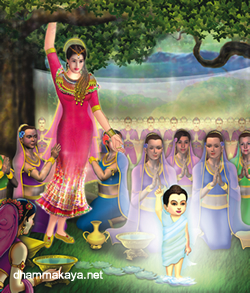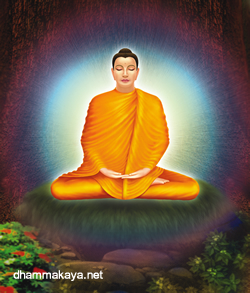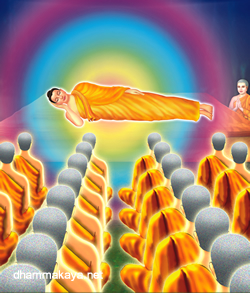Vesak is considered one of the most important days in Buddhism. It is the day where Buddhists come together to commemorate the Lord Buddha and his teachings and to demonstrate our admiration for his immense and great wisdom.Vesak also marks the anniversary of three significant events in the Lord Buddha’s life which includes his birth, enlightenment, and passing into Nirvana.
According to the Thai lunar calendar, Vesak normally takes place in May, but in the case of a year with an extra eighth month – adhikamasa – then Visakha Puja will be on the full moon day of the seventh lunar month. This year, Vesak falls on the full moon day on Monday, June 4, 2555 B.E. (2012). However, in some countries Visakha Puja may be celebrated on a different day, depending on their time zone.
Visakha Puja commemorates three important events in the life of the Lord Buddha – his birth, enlightenment, and passing into Nirvana. These three separate events incredibly happened on the full moon day of the sixth month in their respective years.
His Birth
When Queen Siri Maha Maya, King Suddhodana’s Royal Consort, was due to give birth, she traveled to Devadaha city as it was the royal tradition. While on her way to the city, she stopped to rest under the sala tree at Lumbini Park. As she was standing and holding on to a sala tree, she gave birth to a prince. The birth happened on the full moon day, eighty years before the Buddhist Era. When the prince was five days old, he was given the name ‘Siddhatha,’ meaning ‘fulfillment’.
 The news of Prince Siddhatha’s birth spread far and wide, eventually reaching Hermit Asitha, an acquaintance of King Suddhodana who resided in the Himalayas. Hermit Asitha requested for a visit to see the newborn prince. When he saw the prince, he predicted that the prince would be self-enlightened and discover the path to Nirvana, and would eventually become the Lord Buddha. The prince would teach the people the ways to end suffering and spread love and kindness to humankind. After the prediction was presented, Hermit Asitha bowed respectfully to the prince. When King Suddhodana, feeling overwhelmed with joy, witnessed such an astonishing event, also bowed to the prince. Later on, King Suddhodana invited eight Brahmin scholars, who were specialized in astrology, to look at the prince and to predict his destiny. Seven of them predicted that if the prince were to assume the throne, he would become the Supreme Emperor; however, if he decided to ordain, he would become the Lord Buddha. Kaundinya, the youngest Brahmin, prophesied that the prince would choose the latter path and become the Lord Buddha. He offered such prediction because the prince possessed all the distinguishing marks of a great man.
The news of Prince Siddhatha’s birth spread far and wide, eventually reaching Hermit Asitha, an acquaintance of King Suddhodana who resided in the Himalayas. Hermit Asitha requested for a visit to see the newborn prince. When he saw the prince, he predicted that the prince would be self-enlightened and discover the path to Nirvana, and would eventually become the Lord Buddha. The prince would teach the people the ways to end suffering and spread love and kindness to humankind. After the prediction was presented, Hermit Asitha bowed respectfully to the prince. When King Suddhodana, feeling overwhelmed with joy, witnessed such an astonishing event, also bowed to the prince. Later on, King Suddhodana invited eight Brahmin scholars, who were specialized in astrology, to look at the prince and to predict his destiny. Seven of them predicted that if the prince were to assume the throne, he would become the Supreme Emperor; however, if he decided to ordain, he would become the Lord Buddha. Kaundinya, the youngest Brahmin, prophesied that the prince would choose the latter path and become the Lord Buddha. He offered such prediction because the prince possessed all the distinguishing marks of a great man.
His Enlightenment
It was King Suddhodana’s wish for the prince to continue his reign of the kingdom and to eventually become the Supreme Emperor. He provided his son with every luxury he could ever want or need in the three palaces (for seasonal occupation) filled with beautiful things and gorgeous royal consorts in order to shield the prince from all forms of human suffering that would lead to apathy and the desire to ordain. The life of the prince was one filled with beauty, wealth, health, royal attendants, prestige, fame, and happiness.
 One day, when Prince Siddhatha was 29 years old, he rode his horse outside the palace and encountered an aging person, a sick person, a corpse and an ascetic. The sight of the aged, diseased and the dead caused him to reflect on the uncertainties and sufferings in the lives of all human beings. But upon seeing the ascetic, an individual who was seeking a way out of this suffering, Prince Siddhatha became truly impressed with the lifestyle of an ascetic. It inspired him to become ordained one day.
One day, when Prince Siddhatha was 29 years old, he rode his horse outside the palace and encountered an aging person, a sick person, a corpse and an ascetic. The sight of the aged, diseased and the dead caused him to reflect on the uncertainties and sufferings in the lives of all human beings. But upon seeing the ascetic, an individual who was seeking a way out of this suffering, Prince Siddhatha became truly impressed with the lifestyle of an ascetic. It inspired him to become ordained one day.
Later on, Princess Yasodhara, the prince’s royal consort, gave birth to a son, who was given the name Rahul, meaning ‘fetter’. This name was given because Prince Siddhatha realized that if he did not ordain now, he would not have another opportunity in the future because he would ultimately be bound by the love for his wife and son. That evening he left his palace in order to ordain and to search for the way to overcome suffering.
Six years after leaving the palace and arduously searching, Prince Siddhatha attained enlightenment under the Bodhi tree on the full moon night of the sixth lunar month and became Lord of Buddha at the age of thirty-five. During the first meditative stage he reached, it allowed him to recount every past lifetime that he was born; later he attained what is called ‘the divine eye’ and had the ability to see past lives of all living creatures in the cycle of existence - Samsara. In the final meditative stage that he reached, he was able to eliminate all his defilements through the wisdom he has acquired. Prince Siddhatha was fully enlightened and became the Lord Buddha. At the present day, the location where he attained enlightenment is in the town of Bodh Gaya, located in Gaya city in the Indian state of Bihar.
His Entering into Nirvana
After attaining enlightenment, the Lord Buddha taught Dhamma to the people for the next 45 years until he was 80. On the full moon night of the sixth month, as the Lord Buddha rested in Kusinara city of the Malla Kingdom, he delivered his final discourse as followed: ‘Behold monks, all composite things pass away as a natural order of things. Strive for your  own liberation and the liberation of your fellow humankind with diligence, and without carelessness. He then finally entered Nirvana on the full moon night of the sixth lunar month. The site where the Lord Buddha entered Nirvana is in Kushinagar district in the Indian state of Uttar Pradesh.
own liberation and the liberation of your fellow humankind with diligence, and without carelessness. He then finally entered Nirvana on the full moon night of the sixth lunar month. The site where the Lord Buddha entered Nirvana is in Kushinagar district in the Indian state of Uttar Pradesh.
Vesak and the United Nations
On the 13th of December 2542 B.E. (1999) the General Assembly of the United Nations officially recognized Visakha Puja or Vesak Day, as traditionally known by Sri Lankans, as an International Day of the World. Sri Lanka was the key member of the original group of co-sponsors of the resolution to observe Vesak as a special day at the United Nations. Their goal was to make Vesak internationally known as the day Buddhists throughout the world assemble to perform merit to commemorate the day the Lord Buddha was born, attained enlightenment, and entered into Nirvana. It is also to recognize the Lord Buddha’s great wisdom and the immense compassion and goodwill he had for all living beings.
The General Assembly of the United Nations declared Vesak as an International Day of the World as recognition of the Lord Buddha as a great human being who was kind and compassionate to all of humankind. Lord Buddha encouraged all religious groups to come study his teaching and to verify the truth themselves, without the need to abandon their faith. He taught and shared his great wisdom to all living beings without asking for anything in return.

